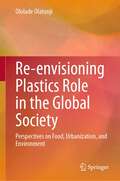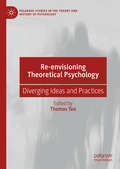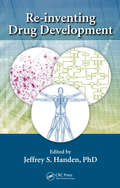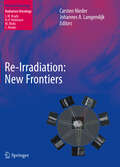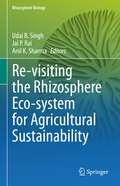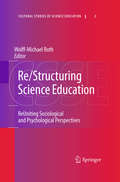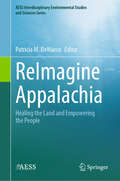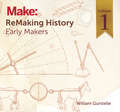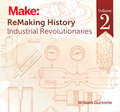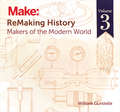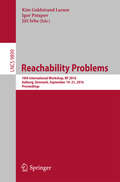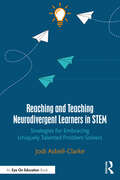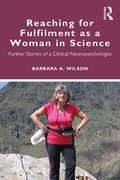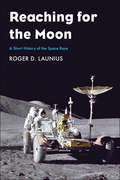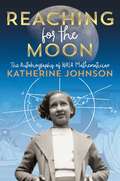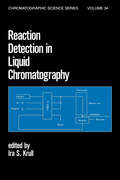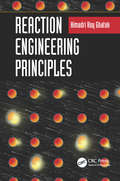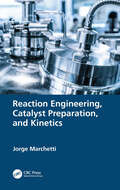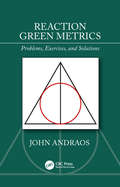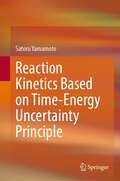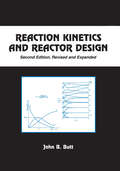- Table View
- List View
Re-envisioning Plastics Role in the Global Society: Perspectives on Food, Urbanization, and Environment
by Ololade OlatunjiThis book covers the challenges and opportunities presented by plastics in the modern era and sheds light on the complex interplay of technology, environment, and socio-economic dynamics. With a thorough exploration of the history, uses, and potential of plastics, the book reviews the impact of plastics beyond single-use plastics, and critiques multiple long-term plastic applications that are significant for food security, water resource management, ecological conservation/restoration, and sustainable urbanization. It also explores frameworks for achieving a more sustainable plastic economy aligned with sustainable development goals. This book comprises 13 chapters, commencing with a critical assessment of plastics in the context of sustainable development and global society. It proceeds with a historical overview of plastics' evolution, showcasing pivotal milestones and innovations in modern industry and daily life. Subsequent chapters delve into diverse topics: the intricate relationships between plastics, food security, and sustainable urbanization; plastics' impact on water safety, management, distribution, and conservation; their potential as an alternative energy source; and their innovative applications in sustainable transportation and energy generation. Emphasis is placed on plastics' role in waste reduction and recycling, as well as the latest sustainable alternatives like biodegradable and recyclable materials. In the book's final sections, readers will learn about green buildings and climate-resilient cities constructed using innovative plastic materials, and plastics' significance in space exploration. The book concludes with a forward-looking perspective on plastics' future, accompanied by recommendations for a more sustainable coexistence between society and these versatile materials. This book is a valuable resource for researchers, policymakers, industry professionals, and concerned citizens seeking to navigate the intricate landscape of plastics, their environmental implications, and their potential for sustainable development.
Re-envisioning Theoretical Psychology: Diverging Ideas and Practices (Palgrave Studies in the Theory and History of Psychology)
by Thomas TeoThis volume presents a re-envisioning of the field of theoretical psychology and offers unique visions for its present and future from leaders of North American philosophical psychology. It contends that theoretical psychology has reached ‘middle-age’ and must consider new directions to renew its growth. Rooted in a range of research traditions and the intellectual biographies of its authors, it paves the way toward this necessary revitalization of the content, activities, responsibilities, and hopes of theoretical psychology. The authors situate their analyses in the context of the increasing gap between alternative and mainstream and between the discipline and the profession of psychology. They demonstrate that changes in society, culture and technology, the internationalization of the psychological humanities, and the cross-fertilization of intellectual innovations from other disciplines now afford possibilities for new orientations in theoretical psychology. The volume aims to do justice to psychological topics, human beings, and the intellectual problems that psychologists encounter, while also providing space for (meta)theoretical engagement, often neglected in the discipline. Together, the chapters in this collection make the case that a renewal of the discipline and practice of psychology is a task that is best accomplished collectively, and, despite significant disagreements, in solidarity.
Re-examining Pedagogical Content Knowledge in Science Education (Teaching and Learning in Science Series)
by Amanda Berry John Loughran Patricia FriedrichsenPedagogical Content Knowledge (PCK) has been adapted, adopted, and taken up in a diversity of ways in science education since the concept was introduced in the mid-1980s. Now that it is so well embedded within the language of teaching and learning, research and knowledge about the construct needs to be more useable and applicable to the work of science teachers, especially so in these times when standards and other measures are being used to define their knowledge, skills, and abilities. Re-examining Pedagogical Content Knowledge in Science Education is organized around three themes: Re-examining PCK: Issues, ideas and development; Research developments and trajectories; Emerging themes in PCK research. Featuring the most up-to-date work from leading PCK scholars in science education across the globe, this volume maps where PCK has been, where it is going, and how it now informs and enhances knowledge of science teachers’ professional knowledge. It illustrates how the PCK research agenda has developed and can make a difference to teachers’ practice and students’ learning of science.
Re-inventing Drug Development
by Jeffrey S. HandenThe biopharmaceutical industry has entered an era of unprecedented change and challenge, characterized by increasing pricing pressures, rising rates of attrition in the product development lifecycle, and decreasing scientific innovation. The most successful products are losing patent protection, and pipelines have been unable to fill the gap. This
Re-irradiation: New Frontiers
by Carsten Nieder Johannes LangendijkNew developments such as refined combined modality approaches and significant technical advances in radiation treatment planning and delivery are facilitating the re-irradiation of previously exposed volumes. As a consequence, both palliative and curative approaches can be pursued at various disease sites. Re-irradiation: New Frontiers is the first book to provide a comprehensive overview on current re-irradiation strategies. Re-irradiation methods, technical aspects, the role of combined therapy with anticancer drugs and hyperthermia, and normal tissue tolerance are all discussed in detail. In addition, disease-specific chapters document recent clinical results and future research directions. Professionals involved in radiation treatment planning and multimodal oncology treatment will find this book to be an invaluable aid in understanding the benefits and limitations of re-irradiation and in designing prospective trials.
Re-visioning Geography: Supporting the SDGs in the post-COVID era (Key Challenges in Geography)
by Aikaterini Klonari Maria Luisa De Lázaro y Torres Athanasios KizosGeography is a discipline with a profound interdisciplinary character focusing on studying the complex interactions between nature and society. Geography can advance the level of knowledge and awareness and provide important contributions to support the achievement of Sustainable Development Goals. This book explores some of these issues, while also disseminating and supporting the efforts of geographers worldwide to promote the implementation of the SDGs. It offers local and global perspectives to a variety of topics covered by the SDGs, such as: How do different actors such as universities, companies and education actors respond to Sustainable Development Goals, especially during the complex context of the COVID pandemic? What is the role of novel spatial technologies and open/big data in achieving SDGs and how can Geography assist? How are new eco-social challenges positioned in a post-pandemic global change? What are novel educational contexts and resources that can be used to transform society toward sustainability of socioecological systems? What conceptual frameworks and strategies can contribute to the construction of societies based on human welfare and the care of nature? This book is focused on innovative sustainability-oriented geographical research on the above (and more) topics that explore the diverse social, environmental, economic and cultural contexts at various spatial scales. It also includes chapters that report on geographical education initiatives in schools and universities, the implication of geographers in community-based learning and increasing community's awareness in terms of environment, climate change and sustainable development as well as chapters that make use of geospatial technologies (e.g., remote sensing, GIS, etc.) both in geographical research and education for sustainable development are particularly relevant for the book.
Re-visiting the Rhizosphere Eco-system for Agricultural Sustainability (Rhizosphere Biology)
by Anil K. Sharma Udai B. Singh Jai P. RaiThe present book entitled, “Re-visiting the Rhizosphere Eco-system for Agricultural Sustainability” written by experts in the field, provides a comprehensive and consolidated state-of art overview of various aspects of rhizosphere biology, ecology and functioning. The role of rhizosphere microbial diversity in enhancing plant health and plant-microbe beneficial symbioses is discussed. Main topics include the diversity of plant-associated microbes in the rhizosphere, below-ground communication among the plant, soil, insects and microbes, rhizosphere ecosystem functioning, rhizosphere engineering, recruitment of microorganisms in the rhizosphere, mycorrhizal fungal symbiosis, positive interaction of the plants with the beneficial soil microorganisms for inducing the plant growth, conferring abiotic and biotic stress tolerance and modulating several pathways of the plants for the proper establishment and revitalization in the degraded and contaminated soils or negative likes the host-pathogen interactions leading to the disease development in plants. Further chapters focus on the role of signaling during the different stages of the plant-microbe coexistence, in symbiotic or pathogenic relationships, in quorum sensing, microbial signaling and cross-talk, bio-film formation, and antimicrobial peptides. The book also discusses the application of microbes in biodegradation of xenobiotic contaminants, bioremediation of heavy metals, sustainable agriculture and soil health, biological control of insect pests and plant pathogens, and the latest tools of omics which offer pioneering approaches to the exploration of microbial structure and function, secretome, holobiome, below-ground interaction, and microbial cooperation for sustainable food production and enhanced resource acquisition. Descriptions of cutting-edge techniques and novel approaches make this book unique in the area of rhizosphere biology. This is a useful reading material for researchers and students of microbiology, agriculture, ecology, and rhizosphser studies.
Re/Structuring Science Education
by Wolff-Michael RothSince its beginnings, science education has been under the influence of psychological theories of knowing and learning, while in more recent years, social constructivist and sociological frameworks have also begun to emerge. With little work being done on showing how the perspectives of these separate approaches might be integrated, this work aims to plug the gap. The book helps lay the groundwork for reuniting sociological and psychological perspectives on the knowing, learning, and teaching of science. Featuring a range of integrative efforts beginning with simple conversation, the chapters here include not only articles but also commentaries that engage with other papers, as well as a useful running narrative that, from the introduction to the epilogue, contextualizes the book and its sections. Specific attention is given to cultural-historical activity theory, which already offers an integration of psychological and cultural-historical (sociological) perspectives on collectively motivated human activities. A number of chapters, as well as the contextualizing narrative, explicitly use this theory as a framework for rethinking science education to achieve the reunification that is the goal of this work. All the contributors to this volume have produced texts that contribute to the effort of overcoming the extant divide between sociological and psychological approaches to science education research and practice. From very different positions--gender, culture, race--they provide valuable insights to reuniting approaches in both theory and method in the field. As an ensemble, the contributions constitute a rich menu of ideas from which new forms of science education can emerge.
ReImagine Appalachia: Healing the Land and Empowering the People (AESS Interdisciplinary Environmental Studies and Sciences Series)
by Patricia M. DeMarcoReImagine Appalachia- Healing the Land and Empowering the People documents the three-year grass-roots collaboration among people, organizations, elected officials and faith leaders to envision and enact into law a blueprint for shared prosperity in the four Appalachia states of KY, OH, PA and WV. In response to industry proposals for a five-plant petrochemical hub in the Ohio River Valley, concerned citizens developed a Blueprint for a new deal that works for all of us: public investment in our communities; building a 21st century sustainable Appalachia; and rebuilding the middleclass. This book captures the process, plans and results of the ReImagine Appalachia campaign as a success story and testament to the power of grassroots organizing for climate action, social equity, and racial justice. It raises the diverse voices and stories of people who built common ground together and changed the laws for a more equitable, healthier world for our children and future generations.
ReMaking History, Volume 1: Early Makers
by William GurstelleWilliam Gurstelle begins his remarkable journey through history with this volume, Early Makers. Each chapter examines a remarkable individual or group of people from the past whose insights and inventions helped create the world we live in. What sets this series apart from other history books - including other histories of technology - is that each chapter also includes step-by-step instructions for making your own version of the historical invention. History comes to life in a way you have never experienced before when you follow the inventors' steps and recreate the groundbreaking devices of the past with your own hands.In this volume you will discover:The Cave Dwellers of Lascaux and the Oil LampPythagoras and the Tantalus CupHeron and the Gin PoleEgypt's Bag PressOtto von Guerke and the Magdeburg HemispheresLevi ben Gershon and the Jacob's StaffJuliana Berners and the Fishing LureArchimedes and the Water ScrewChina's Differential WindlassBe sure to also check out ReMaking History, Volume 2: Industrial Revolutionaries and ReMaking History Volume 3:Makers of the Modern World.
ReMaking History, Volume 2: Industrial Revolutionaries
by William GurstelleIndustrial Revolutionaries is the second volume in William Gurstelle's unique exploration of history's great inventors. Each chapter revisits the life and times of one of the forward-thinking revolutionaries who helped create the world we live in. You will not only learn about their great inventions, you'll also get step-by-step instructions for recreating them yourself. History will come to life as you have never experienced it before when you build it with your own hands. Inside this volume, you will discover:Joseph McKibben and the Air MuscleSquire Whipple and the Iron BridgeAbe Lincoln and the Campaign TorchSamuel Morse and the TelegraphJ.F. Daniell and the Storage BatteryBen Franklin and the Leyden JarCharles Goodyear and the Vulcanization of RubberBe sure to also check out ReMaking History, Volume 1: Early Makers and ReMaking History, Volume 3: Makers of the Modern World.
ReMaking History, Volume 3: Makers of the Modern World
by William GurstelleMakers of the Modern World is the third volume of William Gurstelle's unique, hands-on journey through history. Each chapter examines a remarkable character from the past, one of the people whose insights and inventions helped create our modern world. What sets this series apart from other history books - including other histories of technology - is that each chapter also includes step-by-step instructions for making your own version of the historical invention. History comes to life in a way you have never experienced before when you follow the inventors' steps and recreate the groundbreaking devices of the past with your own hands.This volume brings you to the early modern era and the invention of the electric light, the movie projector, and the automobile. Inside, you will discover:Alessandro Volta and ElectroplatingHumphrey Davy and the First Electric lightGeorge Cayley and the Aeronautical GliderThe Lumiere Brothers and the Movie ProjectorRudolf Diesel and the Automobile EngineHans Goldschmidt and the Thermite ReactionAugust Mobius and the Mobius StripLouis Poinsot's Loads, Moments, and TorquesBe sure to also check out ReMaking History, Volume 1: Early Makers and ReMaking History Volume 2 :Industrial Revolutionaries.
Reachability Problems
by Kim Guldstrand Larsen Igor Potapov Jiří SrbaThis book constitutes the proceedings of the 8th International Workshop on Reachability Problems, RP 2014, held in Oxford, UK, in September 2014. The 17 papers presented in this volume were carefully reviewed and selected from 25 submissions. The book also contains a paper summarizing the invited talk. The papers offer new approaches for the modelling and analysis of computational processes by combining mathematical, algorithmic, and computational techniques.
Reachability Problems
by Igor Potapov Matthew HagueThis book constitutes the refereed proceedings of the 11th International Workshop on Reachability Problems, RP 2017, held in London, UK, in September 2017. The 12 full papers presented together with 1 invited paper were carefully reviewed and selected from 17 submissions. The aim of the conference is to bring together scholars from diverse fields with a shared interest in reachability problems, and to promote the exploration of new approaches for the modelling and analysis of computational processes by combining mathematical, algorithmic, and computational techniques. Topics of interest include (but are not limited to): reachability for innite state systems; rewriting systems; reachability analysis in counter/timed/cellular/communicating automata; Petri nets; computational aspects of semigroups, groups, and rings; reachability in dynamical and hybrid systems; frontiers between decidable and undecidable reachability problems; complexity and decidability aspects; predictability in iterative maps, and new computational paradigms.
Reaching and Teaching Neurodivergent Learners in STEM: Strategies for Embracing Uniquely Talented Problem Solvers
by Jodi Asbell-ClarkeProviding salient stories and practical strategies, this book empowers educators to embrace the unique talents of neurodivergent learners in science, technology, engineering, and mathematics (STEM). An exploration of the exciting opportunities neurodiversity presents to build an innovative workforce is grounded in a large body of research from psychology, neuroscience, and education. Author Jodi Asbell-Clarke presents individual examples of neurodivergent journeys in STEM to establish evidence-based connections between neurodiversity and the types of innovative problem-solving skills needed in today’s workforce. The featured stories come directly from the author’s many years in inclusive classrooms with STEM teachers along with interviews from many neurodivergent professionals in STEM. Teachers will learn how to embrace the unique brilliance and potential of the neurodivergent learners in their classroom, working against historic marginalization and deficit-based perspectives of neurodiversity within the education system. Featuring illustrations of classroom-designed tools and materials alongside basic strategies to support executive function and emotion in learning, this book will help you nurture the talents of your neurodivergent learners and recognize their unique potential within STEM. Ideal for K-12 classroom teachers, special educators, learning specialists, psychologists, and school administrators.
Reaching for Fulfilment as a Woman in Science: Further Stories of a Clinical Neuropsychologist
by Barbara A. WilsonThis vivid memoir presents adventures from the life of Barbara A. Wilson, an internationally honoured scientist who played an influential role in the development of neuropsychological rehabilitation at a time when the scientific field was dominated by men. As a follow-up to the highly successful Story of a Clinical Neuropsychologist, this book includes a host of memories, both personal and professional, which focus on Barbara’s development of her career as a woman in science. From childhood recollections and travels in Africa, to lifetime achievement awards and the restrictions of global pandemics, Barbara tells the story of her full and varied life and her unparalleled career in neuropsychological rehabilitation. Her book indicates that one can lead a meaningful and full life even after one of the most awful of losses, the death of a child, and also emphasizes the need to stick to one’s principles in trying times. The result is an unparalleled insight into the life of a clinical neuropsychologist, which can encourage the next generation of professionals who are trying to balance career, international travel and family, as well as inspire any girls interested in entering the world of science.
Reaching for the Moon: A Short History of the Space Race
by Roger D LauniusFifty years after the Moon landing, a new history of the space race explores the lives of both Soviet and American engineers At the dawn of the space age, technological breakthroughs in Earth orbit flight were both breathtaking feats of ingenuity and disturbances to a delicate global balance of power. In this short book, aerospace historian Roger D. Launius concisely and engagingly explores the driving force of this era: the race to the Moon. Beginning with the launch of Sputnik 1 in October 1957 and closing with the end of the Apollo program in 1972, Launius examines how early space exploration blurred the lines between military and civilian activities, and how key actions led to space firsts as well as crushing failures. Launius places American and Soviet programs on equal footing—following American aerospace engineers Wernher von Braun and Robert Gilruth, their Soviet counterparts Sergei Korolev and Valentin Glushko, and astronaut Buzz Aldrin and cosmonaut Alexei Leonov—to highlight key actions that led to various successes, failures, and ultimately the American Moon landing.
Reaching for the Moon: The Autobiography of NASA Mathematician Katherine Johnson
by Katherine Johnson&“This rich volume is a national treasure.&” —Kirkus Reviews (starred review) &“Captivating, informative, and inspiring…Easy to follow and hard to put down.&” —School Library Journal (starred review) The inspiring autobiography of NASA mathematician Katherine Johnson, who helped launch Apollo 11.As a young girl, Katherine Johnson showed an exceptional aptitude for math. In school she quickly skipped ahead several grades and was soon studying complex equations with the support of a professor who saw great promise in her. But ability and opportunity did not always go hand in hand. As an African American and a girl growing up in an era of brutal racism and sexism, Katherine faced daily challenges. Still, she lived her life with her father&’s words in mind: &“You are no better than anyone else, and nobody else is better than you.&” In the early 1950s, Katherine was thrilled to join the organization that would become NASA. She worked on many of NASA&’s biggest projects including the Apollo 11 mission that landed the first men on the moon. Katherine Johnson&’s story was made famous in the bestselling book and Oscar-nominated film Hidden Figures. Now in Reaching for the Moon she tells her own story for the first time, in a lively autobiography that will inspire young readers everywhere.
Reaching for the Sun
by John KingFrom their ability to use energy from sunlight to make their own food, to combating attacks from diseases and predators, plants have evolved an amazing range of life-sustaining strategies. Written with the non-specialist in mind, John King's lively natural history explains how plants function, from how they gain energy and nutrition to how they grow, develop and ultimately die. New to this edition is a section devoted to plants and the environment, exploring how problems created by human activities, such as global warming, pollution of land, water and air, and increasing ocean acidity, are impacting on the lives of plants. King's narrative provides a simple, highly readable introduction, with boxes in each chapter offering additional or more advanced material for readers seeking more detail. He concludes that despite the challenges posed by growing environmental perils, plants will continue to dominate our planet.
Reaction Detection in Liquid Chromatography (Chromatographic Science Ser. #34)
by Ira S. KrullThe first book to focus entirely on reactions for analyte detection and characterization,Reaction Detection in Liquid Chromatography depicts off- and on-line, pre- and postcolumnapproaches that have been successfully used for many classes of compounds, bothorganic and inorganic, in high performance liquid chromatography.The book gives special attention to methods and instrumentation associated with postcolumnreaction detection, discussing theory, background, principles, and equations .. .and also highlights major areas of reaction chemistry, such as immobilized ( or solution)enzymatic reactions, homogenous solution chemistry, photochemical derivation, pairedionreagents, solid phase and solid supported reagents, and reactions for inorganic species.In addition, Reaction Detection in liquid Chromatography details the efficiencies of thevarious reactions surveyed ... forecasts how the utility of each reaction is likely to be enhancedby new research ... and gives data that will allow the reader to reproducereaction-detection approaches for new analytes and samples.Reaction Detection in Liquid Chromatography is essential reading for analytical, bioanalytical,quality control, and research and development chemists. It also comprises a finereference for analysts involved in development and applications of liquid chromatographyfor specific qualitative and quantitative analyte identification; and in-house, professionalseminars.
Reaction Engineering Principles
by Himadri Roy GhatakChemical reaction engineering is at the core of chemical engineering education. Unfortunately, the subject can be intimidating to students, because it requires a heavy dose of mathematics. These mathematics, unless suitably explained in the context of the physical phenomenon, can confuse rather than enlighten students. Bearing this in mind, Reaction Engineering Principles is written primarily from a student’s perspective. It is the culmination of the author’s more than twenty years of experience teaching chemical reaction engineering. The textbook begins by covering the basic building blocks of the subject—stoichiometry, kinetics, and thermodynamics—ensuring students gain a good grasp of the essential concepts before venturing into the world of reactors. The design and performance evaluation of reactors are conveniently grouped into chapters based on an increasing degree of difficulty. Accordingly, isothermal reactors—batch and ideal flow types—are addressed first, followed by non-isothermal reactor operation, non-ideal flow in reactors, and some special reactor types. For better comprehension, detailed derivations are provided for all important mathematical equations. Narrative of the physical context in which the formulae work adds to the clarity of thought. The use of mathematical formulae is elaborated upon in the form of problem solving steps followed by worked examples. Effects of parameters, changing trends, and comparisons between different situations are presented graphically. Self-practice exercises are included at the end of each chapter.
Reaction Engineering, Catalyst Preparation, and Kinetics
by Jorge MarchettiThis book serves as an introduction to the subject, giving readers the tools to solve real-world chemical reaction engineering problems. It features a section of fully solved examples as well as end of chapter problems. It includes coverage of catalyst characterization and its impact on kinetics and reactor modeling. Each chapter presents simple ideas and concepts which build towards more complex and realistic cases and situations. Introduces an in-depth kinetics analysis Features well developed sections on the major topics of catalysts, kinetics, reactor design, and modeling Includes a chapter that showcases a fully worked out example detailing a typical problem that is faced when performing laboratory work Offers end of chapter problems and a solutions manual for adopting professors Aimed at advanced chemical engineering undergraduates and graduate students taking chemical reaction engineering courses as well as chemical engineering professionals, this textbook provides the knowledge to tackle real problems within the industry.
Reaction Green Metrics: Problems, Exercises, and Solutions
by John AndraosThis book contains a series of exercises and problems posed in the subject of green metrics. Essentially it is a "how to" book on evaluating the material efficiency, environmental impact, safety-hazard impact, and energy efficiency of any kind of chemical reaction or synthesis plan. Only the essential green metrics in each of these categories are used. The introduction highlights the hierarchy of metrics used throughout the book, explains the structure of how the book is arranged, how the problems are posed, and how the reader is to use the book. Examples refer to themes according to the headings given in the table of contents and are arranged in a hierarchical order.
Reaction Kinetics Based on Time-Energy Uncertainty Principle
by Satoru YamamotoThis book proposes a completely unique reaction kinetics theory based on the uncertainty principle of quantum mechanics; the physical viewpoint and mathematical details for the theory construction are explained, and abundant applications of the theory mainly in materials science are described. The theory argues that physical systems on reaction are in a quantum-mechanically uncertain state, and that such systems will transition to new states after a finite duration time. Based on this theory, if the magnitude of the energy uncertainty, i.e., energy fluctuation of the system on reaction can be determined, we can calculate the reaction rates not only for the thermal activation processes but also for the non-thermal activation process such as mechanical, optical, electromagnetic, or other actions. Therefore, researchers or engineers who are involved in fields such as the discovery of new chemical substances, development of materials, innovation of manufacturing processes, and also everyone purely interested in kinetic methodology find this book very stimulating and motivating.
Reaction Kinetics and Reactor Design (Chemical Industries)
by John B. ButtThis text combines a description of the origin and use of fundamental chemical kinetics through an assessment of realistic reactor problems with an expanded discussion of kinetics and its relation to chemical thermodynamics. It provides exercises, open-ended situations drawing on creative thinking, and worked-out examples. A solutions manual is als
